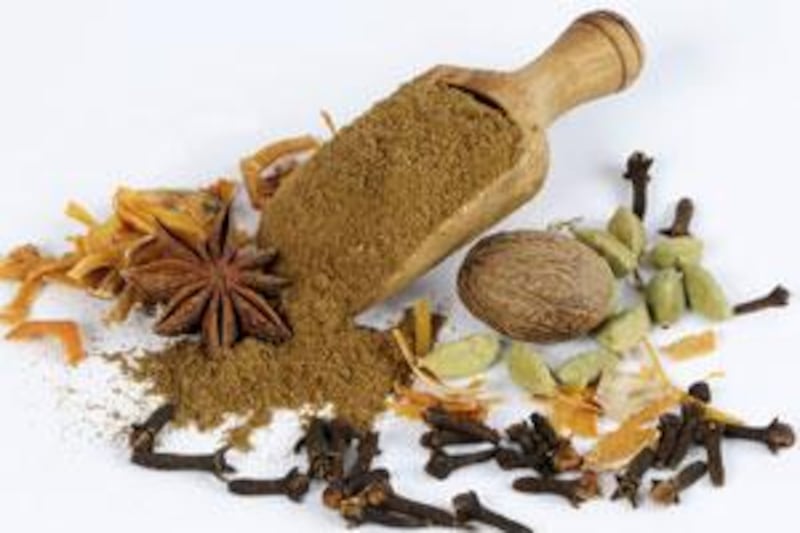"You want spicy? I'll give you spicy!" Saleem Qureshi, the executive chef for Asha's Restaurant, grins as he offers up this friendly challenge, then watches as I sniff each tiny earthenware pot. "Fenugreek," he says, as I inhale the first. "That's mace and green cardamom," as I smell another. The colours are beautiful, from burnt sienna to olive green, but the scents of the freshly ground spices are what reach deep into you, heady and earthy.
"This is garam masala," he says, pointing to the last. "Here you have all the spices in one form." The smell is too complex to adequately describe. I finally (lamely) write "wonderful" in my notebook. The most aromatic of all Indian spice blends, garam masala is used throughout northern India. Garam means "hot", as in temperature (the whole spices are usually roasted before being ground), and masala means "spice blend". But which spices? That's a personal question for most Indian cooks and varies from region to region and household to household. A Northwest Indian garam masala such as the one created in Asha's kitchens would probably include cloves, green and black cardamom, cinnamon and nutmeg. (Many garam masala spices are more widely used in the West for sweet baking). But in Kashmir, fennel, cumin, turmeric and chillies would also be added to the blend. And it's not just for meat curries. "Use it with vegetables, fish, anything," Qureshi says.
What's most important is grinding the spices fresh. While you can easily buy garam masala already ground, the mix soon loses its aroma. Whole spices keep fresh longer and can be ground when needed. All six of Asha's restaurants in the Gulf (one is located in Abu Dhabi's Khalidiyah Mall, another in Dubai's Wafi City) grind their spices, including their signature garam masala. "Spices are everything," says Qureshi. "Indian cooking is very simple. If you have good spices, you'll have good dishes." The recipes below - the first for garam masala, the second for a dish featuring it - promise both.
Asha's garam masala The original recipe calls for mace and dried rose petals, both difficult to find locally. I've eliminated the rose petals and substituted nutmeg for the mace (they come from the same fruit). Makes 35 grams. Ingredients 2 tsp whole cloves 1 tbsp cumin seeds 1 medium cinnamon stick, broken into pieces 2 tsp green cardamom pods 1½ tsp whole black peppercorns
1 whole nutmeg 4 bay leaves 1½ tsp coriander seeds 2 tsp fennel seeds 4 black cardamom pods Method Heat a small, dry frying pan over medium-high heat, then add the spices, stirring frequently until they are several shades darker and fragrant. Be careful not to let them burn, cooking and stirring for six to seven minutes. Cool, then place in a blender and grind. Transfer to a spice or coffee grinder and grind to a fine powder. Store in a clean jar with a tightfitting lid at room temperature.
Chandni chowk ka keema (lamb curry) Asha Bhosle, the beloved Bollywood singer, is the guiding spirit behind Asha's restaurants. Now 75 and living in Mumbai, she continues to perform and record - and cook. This spicy dish, named for the famed Old Delhi market, features minced lamb and Asha's garam masala. Serves 6. Ingredients 180ml corn oil 3 bay leaves 1 large onion, chopped
3 tbsp ginger-garlic paste 1.5kg leg of lamb, minced 150g almonds, whole 20ml water 2 tbsp ground coriander 2 tsp red chilli powder 2 tbsp ground cumin 2 tbsp garam masala 1 tsp salt 2 small tomatoes, chopped 1 bunch fresh coriander, chopped 3 tbsp almond flakes Method Heat the oil in a large frying pan. Add the bay leaves and sauté for 2 minutes over medium heat. Add the chopped onions, stirring and cooking until golden. Add the ginger-garlic paste and cook for 3-4 minutes. Add the minced lamb and sauté for 10-15 minutes over medium-high heat, stirring to break up the pieces.
While the meat is cooking, put the whole almonds in a blender and grind to a smooth powder. Transfer the powder to a small bowl and add the water to make a paste. Add the ground coriander, chilli powder, cumin, garam masala and salt to the meat in the frying pan and cook for another 15-20 minutes. Add the chopped tomatoes and fresh coriander and cook for 10-15 minutes. Remove the bay leaves. Add the almond paste and cook for another 10 minutes. Garnish individual servings with almond flakes. Serve with basmati rice.











